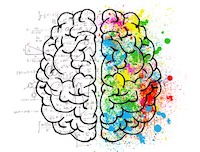Six Thinking Hats is an approach for creativity that was created by Edward DeBono. I use it as the basis for an agile retrospective, and find this approach to be particularly effective when the topic we’re discussing is expected to be controversial or heated.
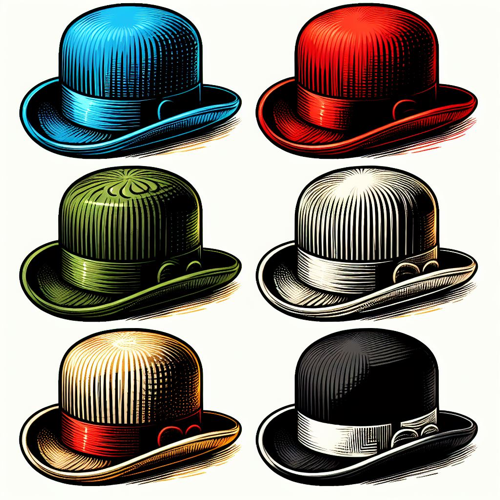
Six Thinking Hats basics
If I were to say to you that “I’m going to put my manager hat on now”, you would immediately understand that I’m looking at the current situation as a manager. I’m adapting my view of the problem and focusing through a specific lens so I see those things that are relevant to a manager.
If I then said that “I’m going to take off that hat and put on my parent hat”, you would immediately understand that I’ve changed my perspective and am now looking at the problem in a different way.
This is the essence of Six Thinking Hats. We have six very specific hats that offer up one specific view into the problem space. We consider the problem from that one perspective and take whatever learning we need from it. Then we try on a different hat and do the same from a different perspective.
As I’m writing this, I’m wearing the Blue Hat. I’m talking about process and the bigger picture. Any conversation we have, will generally start and end with the blue hat.
As I put on the White Hat, I focus on what we know. What data might we have about the process? Well we know that we write our ideas on sticky notes of the appropriate colour. That a fact. We know that as a group, we’re focusing on only one colour at a time before moving on to the next. That’s also a fact.
Now I put on the Red Hat and consider how I feel about that. Perhaps I love the idea of colour coding or maybe it makes me feel uncomfortable. Perhaps I get frustrated at being constrained by the rules because I want to do all colours at once. All of these are feelings and belong in the red.
When I put on the Green Hat, I consider alternatives. We know we can do thinking hats with paper on a wall and perhaps we could do that in an online tool as well. We’re often considering constraints when wearing the green hat so I might realize that not everyone will be in the same room so an online tool is better. Or I might want to find an alternative that is faster or cheaper. All of these are looking at alternative ways.
Now I put on the Yellow Hat and consider all the positive things. As humans, we’ve evolved to be really good at spotting the negative and it can sometimes be hard to find the positive. So we have a hat devoted to that. With the yellow hat on, I can see why that’s so good. I can also see that the hats are driving conversations that might otherwise not have happened. That’s a positive.
Then with the Black Hat, I consider all the downsides, and judgements, and risks. I realize that even with a facilitated session, there is a risk that important topics won’t be brought up. I also realize that finding black sticky notes1 will be difficult and black markers won’t write on them so that adds complexity.
Lastly, returning to the Blue Hat again, I can start to look for patterns and lessons that we can take from the information we’ve put down.
To recap, the hats are below. Note that the approach does not mandate any specific order of walking through the hats, although I generally do it in the order below.
| Hat | Purpose |
|---|---|
| Blue Hat | The high level process view. |
| White Hat | Just the data. What facts do we know? |
| Red Hat | How do we feel about that? |
| Green Hat | What else is possible? Looking at alternative ways, often with a constraint. |
| Yellow Hat | What’s the positive side that that? |
| Black Hat | What are the downsides and risks? |
Using it in a retro
So how do we incorporate this into a retro? The short answer is that there’s no right way to do this. What’s described below is my approach but there are many ways you might incorporate it.
The steps that I follow through any retrospective are described in my video course Retrospective Magic so I’m not going to repeat all of that. The steps that are unique to this retrospective are diverge, converge, and actions so I’m only going to talk through that part.
If we’re in-person, I ask people to write their name on a blue sticky note and put it in front of themselves. This makes it more likely that they’ll actually interact with the sticky notes once we start.
I give the preamble of what Six Thinking Hats is, as described above, but stopping after talking about the blue hat. I explain that I’m wearing the blue hat now.
If there’s a specific topic or some ideas that I want to seed then I talk about that at this point.
Unless I have a specific reason to start somewhere else, I start with the White Hat. Focusing on data and facts will tend to defuse any tension or strong feelings that might have been brought into the retro. In the case where I’m expecting heated arguments, I’ll really stress the notion of data and facts without emotion and may spend more time in this section.
I will often have to point out that what someone wrote is a feeling and we only care about facts here. Encourage them to rewrite the sticky to be just the data.
I encourage people to spread the white stickies out as we may need room between them. I also ask them to move similar things closer to each other and to remove duplicates as they see them.
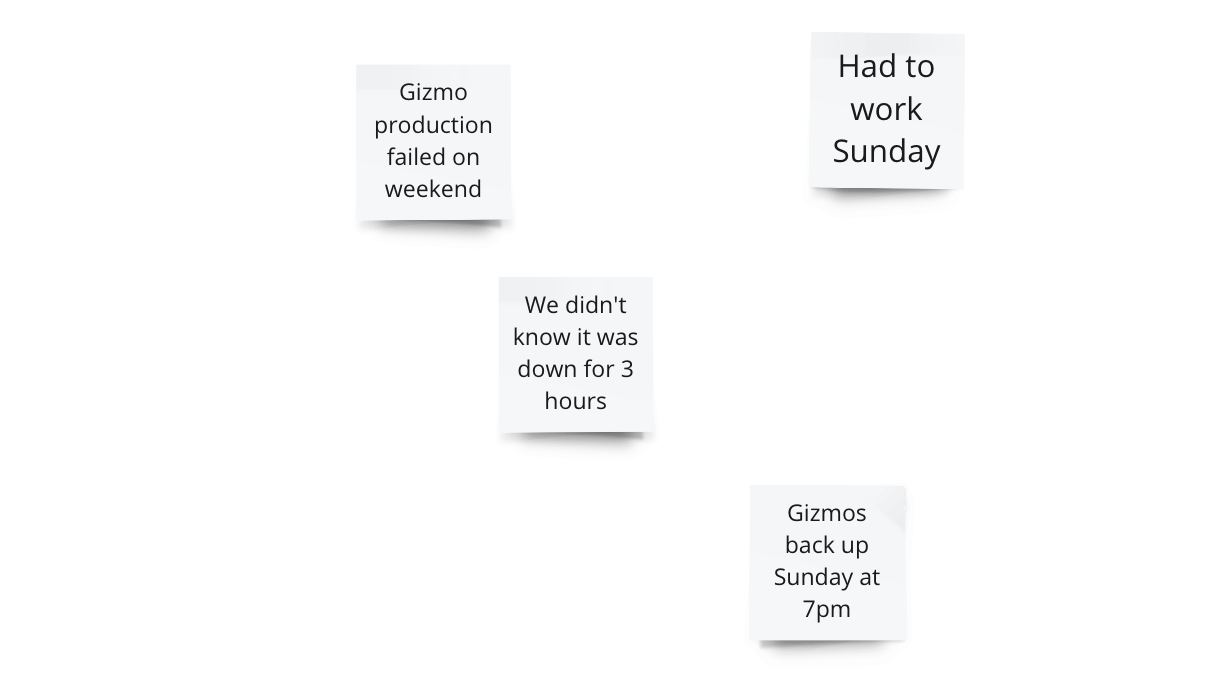
When I see the pace slowing and fewer cards being written, we’ll move on to the Red Hat. This is where we talk about how we feel about things. If the feeling is related to a white card then I ask them to move the cards to be overlapping, as you can see in the picture below.
If it’s unrelated to any data currently on the board then just put it out on its own. In the case here, we see “had been worried this would happen” is a valid feeling and yet there is likely a fact that we should have captured. If I feel that the feeling cards have uncovered a lot of missing data then I might move back to white for a while. If it’s only one or two things then we’ll get back to that later.
We sometimes find that they didn’t leave enough room between white stickies so I remind them that it’s ok if they move things to make room.
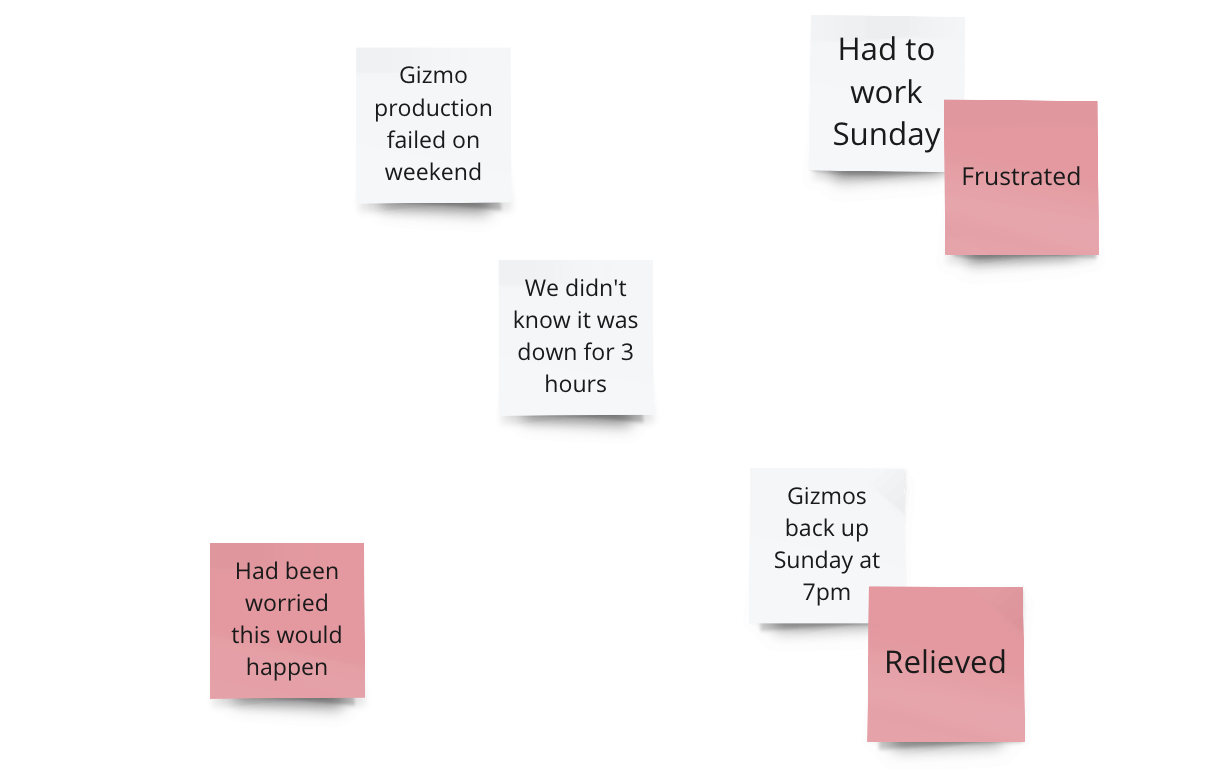
When activity on the red hat slows, we move on to green. What alternatives can we identify? In this case, we could have added extra checks at one step. There’s only one green on this board but that’s because I’m trying to keep the example simple. We usually have a large number of sticky notes for every colour.
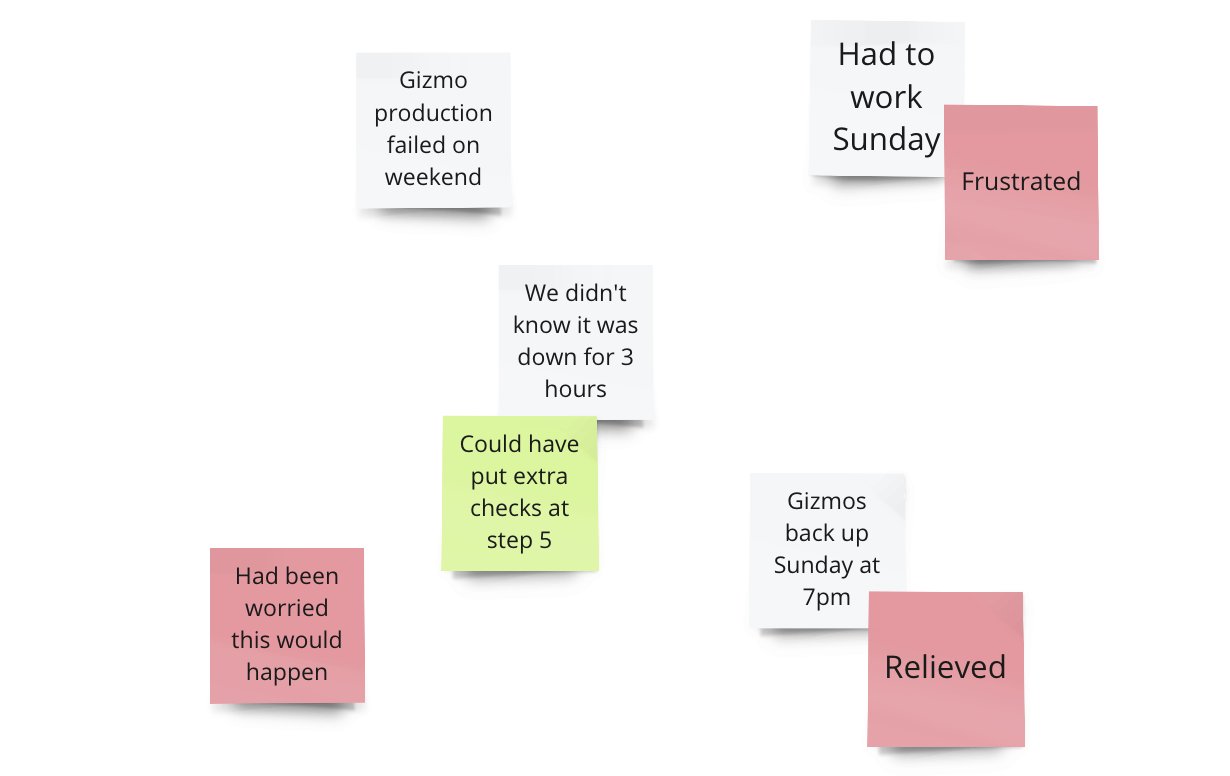
Next we move on to yellow - what’s the positive. Some groups need some help getting started with this and others just flood the board with yellow cards. Every group and every situation is different.
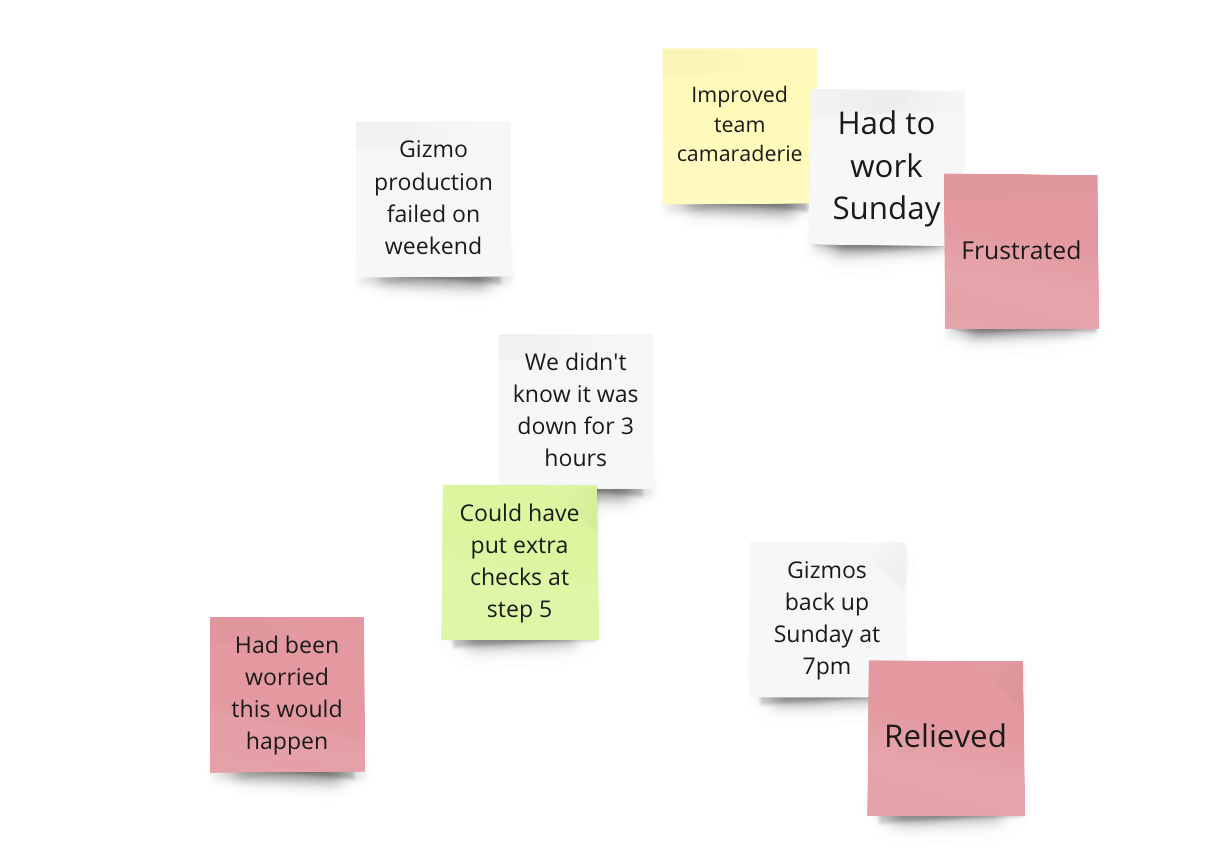
Then we put on the black hat. Judgements, risks, negatives of all kinds. Most teams are really good at finding the black hat items.
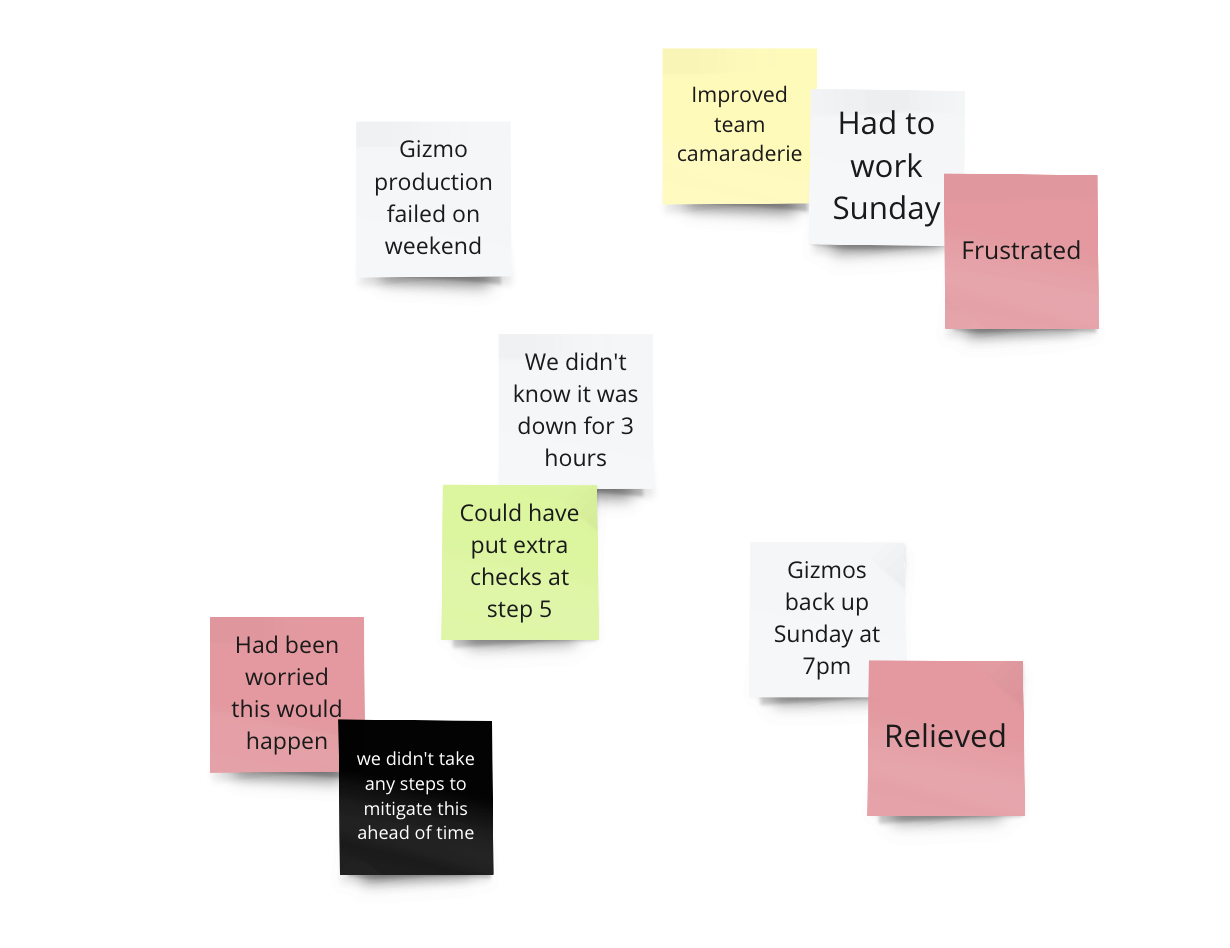
At this point, we want to fill in anything we might have missed. If I feel there is one area that is particularly uncovered then we might go back as a group to that hat. Otherwise, I might just ask people to write down anything they might have through about on the way, asking them to use the correct colour for each card.
This might require multiple passes or reminders. For example, someone might start by adding a data card for “nobody raised any concerns”, as shown here.
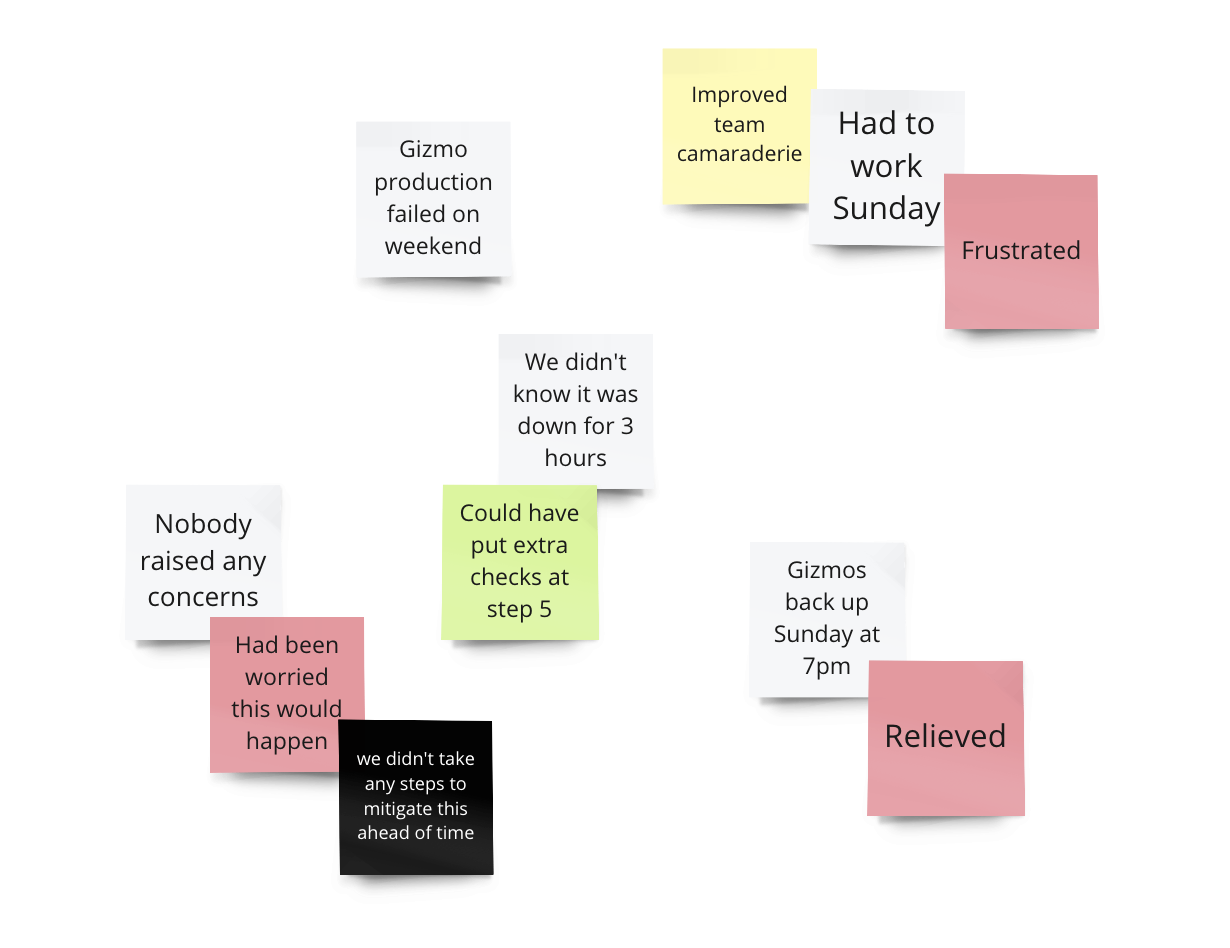
… and someone else might then add a feeling card for “didn’t feel safe to speak up”, which could indicate psychological safety issues.
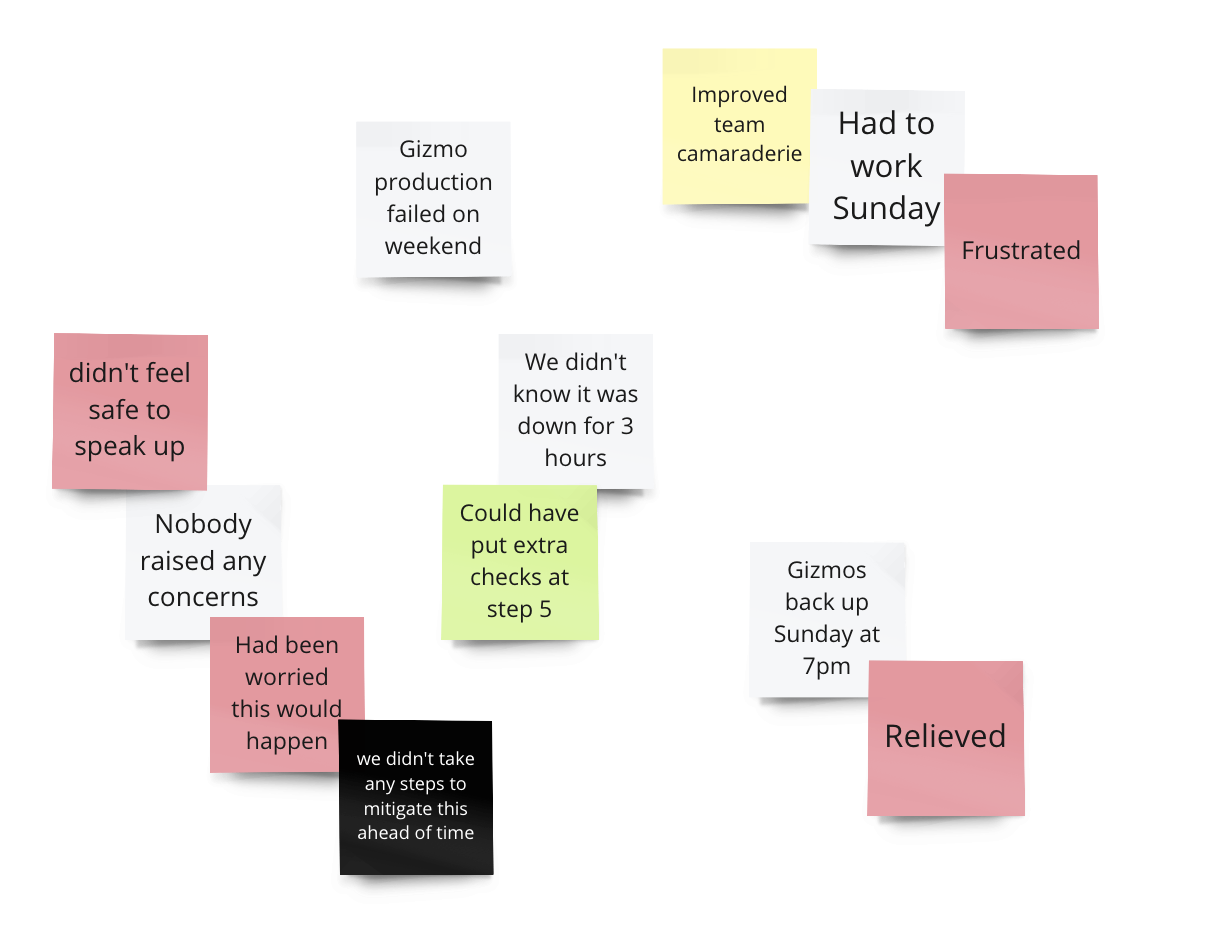
While people are filling in any remaining cards, I ask everyone to look through the board to see patterns and understand what’s there.
What we have now is a large collection of interconnected ideas. The next step is to try to identify potential actions that we might take out of this. I ask people to write the actions on blue cards because blue is process and we’re now back to that hat.
We’re still trying to be creative at this point so there are no bad ideas. Write down whatever actions you think might be possible. The fact that we’ve written down an action doesn’t mean that we’re going to do it.
When all actions are visible, we cluster and remove duplicates just as we would for any other kind of retrospective. We vote on the actions to see where the focus should be and we start talking through possible actions from the highest voted item first.
When we’ve determined at least one action (and not more than three) that we’re going to do then we’re done. There will be far more ideas still on the board than we’re going to actually do anything with. If they’re important they’ll come up again in future retrospectives.
That’s it. Try it out and see how it works.
For more information on Six Thinking Hats itself, see Edward Debono’s book on the topic.
-
Black sticky notes do exist but they’re rarely stocked in-store so I’ve always ordered them online. You’ll also need a different colour marker. I like silver markers for the black sticky notes but the silver doesn’t write well on some of the other colours so you’ll need a mix of markers. ↩
